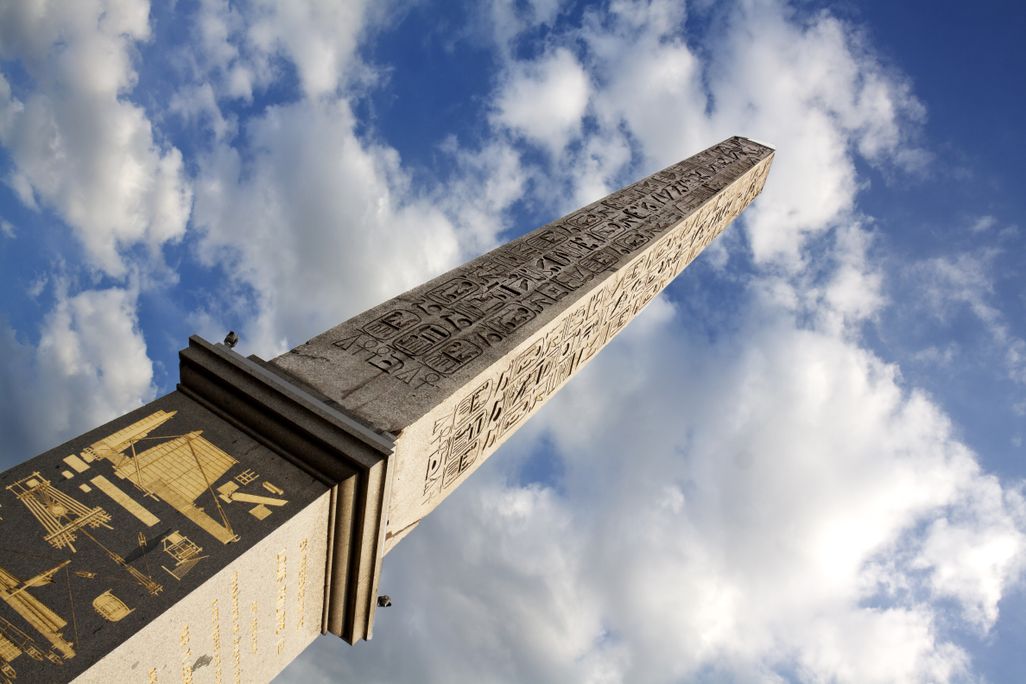Egyptologist Reveals Mysterious Messages Hidden in the Hieroglyphics on a 3,000-Year-Old Obelisk
Cool Finds
Egyptologist Reveals Mysterious Messages Hidden in the Hieroglyphics on a 3,000-Year-Old Obelisk
Jean-Guillaume Olette-Pelletier says he has identified seven sets of crypto-hieroglyphs on the 75-foot-tall structure, which France received as a gift in 1836
The obelisk once stood outside a temple in Luxor, Egypt.
Daniel Candal via Getty Images
A French Egyptologist says he has deciphered secret messages engraved on a 3,000-year-old Egyptian obelisk built during the reign of Ramses II.
The 75-foot-tall stone structure once loomed outside a temple in Luxor, Egypt. But since 1836, it’s stood at Place de Concorde, a public square in Paris. The obelisk is covered in hieroglyphics—the ancient Egyptians’ pictorial writing system—and engraved with both names that Ramses used as king.
During his long reign in the 13th century B.C.E., the pharaoh left his mark all over Egypt, commissioning new structures and even adding his name to older monuments. The Concorde obelisk was one of two red granite columns that Ramses raised outside Egypt’s Luxor Temple. In the 1830s, Ottoman Egypt sent one of them to France, where it’s remained ever since.
Several years ago, Jean-Guillaume Olette-Pelletier, an Egyptologist at the Sorbonne and the Catholic University of Paris, began studying the obelisk on his neighborhood strolls.
“I would walk up to it and read the hieroglyphs on its surfaces to relax,” Olette-Pelletier tells Sciences et Avenir’s Marine Benoit. “At one point, I realized something unusual: The hieroglyphs’ meaning indicated a direction, that of the entrance to the portico of the Temple of Luxor. But that was just the beginning.”
Jean-Guillaume Olette-Pelletier studying the obelisk
Jean-Guillaume Olette-Pelletier
Olette-Pelletier couldn’t find other research related to his observation, so he began his own. After analyzing the obelisk’s engravings with binoculars, he figured out that the pillar contains multiple pieces of code called crypto-hieroglyphs.
Crypto-hieroglyphs were discovered in the 1950s by the Egyptologist Canon Étienne Drioton. They featured “puzzles and wordplay, such as changing the reading direction,” according to Artnet’s Richard Whiddington.
As Olette-Pelletier tells Sciences et Avenir, “Although some Egyptians could read hieroglyphs, only certain elites were capable of understanding the hidden messages that they could contain, considered a language of the gods.”
Olette-Pelletier got to see the Concorde obelisk up close in 2021, when it was surrounded by scaffolding for conservation work ahead of the Olympic Games. Seeing an opportunity, the researcher requested to ascend the scaffolding to examine the upper sections of the obelisk, where he was able to confirm his suspicions.
In its original location, the obelisk towered over the banks of the Nile. Judging by the location and angle of its coded messages, they were probably meant to be read by passengers aboard an approaching boat. As Olette-Pelletier tells Artnet, one message was likely intended for upper-class Egyptians arriving at the temple for an annual festival.
Based on the messages' position, Olette-Pelletier thinks they would have been read by passengers in approaching boats.
Jean-Guillaume Olette-Pelletier
“Given the angle of approach, the nobility would have seen the hidden message and reflected: ‘The king confirms himself as god incarnate, who cannot be dethroned,’” Olette-Pelletier adds. “It was propaganda aimed at the very high intellectual elite.”
Olette-Pelletier happens to be one of the few Egyptologists capable of deciphering crypto-hieroglyphs. In 2021, he published a study translating some cryptographic hieroglyphs upon a small throne of the Egyptian pharaoh Tutankhamun.
In total, Olette-Pelletier identified seven crypto-hieroglyphs on the Concorde obelisk. Some of them, for example, instruct viewers to make offerings to the gods. The researcher plans to detail his findings in a study scheduled for publication in the Egyptology journal ENiM.
“The use of hieroglyphic cryptography allows us to provide a new reading of pharaonic texts,” Olette-Pelletier tells Artnet. “It’s an example proving that Egyptology still holds a lot of things waiting to be discovered.”
Get the latest stories in your inbox every weekday.


